CPM Calculator
Frequently Asked Questions
1. What does CPM mean in advertising?
Answer:
CPM stands for Cost Per Mille, meaning the cost per 1,000 ad impressions. It tells you how much you pay every time your ad is shown 1,000 times, regardless of clicks or conversions.
2. How do you calculate CPM?
Answer:
The CPM formula is: (Total Ad Spend ÷ Total Impressions) × 1,000.
For example, if you spent $500 and received 100,000 impressions, your CPM would be $5.
3. What is a good CPM?
Answer:
A good CPM depends on your industry, audience, and ad platform. On average, display ads range from $1–$10 CPM, while highly targeted campaigns or premium placements can cost $20 or more per thousand impressions.
4. What affects CPM rates?
Answer:
CPM can vary based on targeting, competition, seasonality, and ad quality. Factors like location, device type, and audience demographics also impact the price advertisers pay for impressions.
5. What’s the difference between CPM, CPC, and CPA?
Answer:
• CPM: Cost per 1,000 impressions — best for awareness campaigns.
• CPC: Cost per click — best when you want traffic.
• CPA: Cost per acquisition — best for conversions.
Each metric measures a different stage of campaign performance.
6. How can I improve my CPM?
Answer:
You can reduce CPM by improving ad relevance, testing creative formats, refining audience targeting/placements, and increasing engagement rates. Platforms reward ads with high click-through rates and good engagement with lower CPMs.
7. Why is CPM important for brand awareness?
Answer:
CPM measures how efficiently you’re reaching your audience. For awareness campaigns, a lower CPM means you’re getting your message in front of more people for less money, making it ideal for top-of-funnel (TOF) marketing.











